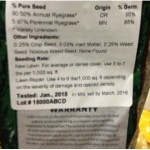(By Evan Alderman, KSU Turfgrass MS Student; Ross Braun, KSU Turfgrass PhD Student; and Jared Hoyle, KSU Turfgrass Research and Extension)
Do you enjoy having a nice green lawn, but didn’t have time to get your fall seeding done? Don’t fret, there is still time. Although the optimal time of year to seed cool season grass species is during the fall months, there is still time for you to get a great looking lawn for this summer. Now before you go to your local garden supply store and pick up some seed, there are several things you should take into account before making your purchase. The art of knowing your seed label begins now.
Turfgrass Species and Cultivar
 So you walk into your local garden supply store and you look at all of your options for potential seed you can use and you say to yourself “I really want a lush green lawn fast”. So you pick up a bag that says something along the lines of “quick establishment”, since that is what you want. Although this bag of seed sounds like a great option, you probably should check out the seed label before making this purchase. In the image is a picture of a seed bag with those claims. As you can see this bag contains 90.50% annual ryegrass (Lolium multiflorum) and only 5.97% perennial ryegrass (Lolium perenne). Now as a turfgrass scientist I can assure you that you may have a great looking lawn temporarily, but annual ryegrass should not be a long term solution. Which is why Rule #1 for the art of knowing your seed label is know what turfgrass species performs best in your area. For much of the state of Kansas, tall fescue (Lolium arundinacea) is the predominant species in most home lawns. Tall fescue is able to handle most of the drought conditions that Kansas likely endures.
So you walk into your local garden supply store and you look at all of your options for potential seed you can use and you say to yourself “I really want a lush green lawn fast”. So you pick up a bag that says something along the lines of “quick establishment”, since that is what you want. Although this bag of seed sounds like a great option, you probably should check out the seed label before making this purchase. In the image is a picture of a seed bag with those claims. As you can see this bag contains 90.50% annual ryegrass (Lolium multiflorum) and only 5.97% perennial ryegrass (Lolium perenne). Now as a turfgrass scientist I can assure you that you may have a great looking lawn temporarily, but annual ryegrass should not be a long term solution. Which is why Rule #1 for the art of knowing your seed label is know what turfgrass species performs best in your area. For much of the state of Kansas, tall fescue (Lolium arundinacea) is the predominant species in most home lawns. Tall fescue is able to handle most of the drought conditions that Kansas likely endures.
Rule #2 for the art of knowing your seed labels is also knowing which species cultivars grow best in your area of the country. One of the best options for knowing which turfgrass cultivars perform best in your area is the National Turfgrass Evaluation Program (www.ntep.org). On their website, there is data available for homeowners to look at from many different university studies involving different turfgrass species and cultivars. This information will help you make an informed decision on what turfgrass species and cultivar will work best for you, this is a step in the right direction for achieving that lush green lawn you are wanting.
Other Seed Label Information
Although some of the most important information on the seed label is the turfgrass species and variety, there are several other pieces of information on the label that can be helpful. Rule #3, look at the percent germination for all turfgrass species on the seed label. Just because that type of seed is on the label doesn’t mean all of it will germinate. Thus it is important to look at the germination rate, and chose a bag of seed that has a high germination percentage. Rule #4, although the bag of turf seed you are going to by mostly contains grass seed, bags of seed can also can weed seed. It is very important to look at the percentage of weed seed in your bag of seed, if that percentage is high, I would probably pass on that bag and look for another one with a lower percent of weed seed. If a seed label has 0.5% weed seed then that equals approximately 12 to 16 weeds being planted per square foot. A seed label with <0.01 weed seed is good but 0% is best. This also applies to the “other crop” section of the label. Lastly, Rule #5, consider the seed testing date on the seed label. As with anything, turfgrass seed can get old, this will highly effect the germination percentage from that bag of seed. It is recommended to use newer seed and avoid anything over one year past the testing date.
Utilizing these five rules will help you make an informed decision for planting a lush green lawn this spring.
Always remember to READ THE LABEL for the correct rate, turfgrass tolerance, and specific instructions before application!!!
***Mention of trade names or commercial products in this article is solely for identification purposes and does not imply recommendation or endorsement, nor is criticism implied of similar products not mentioned by Kansas State University.***
Don’t forget to follow me on twitter @KSUTurf.
Also, visit our facebook page www.facebook.com/KSUTurf
